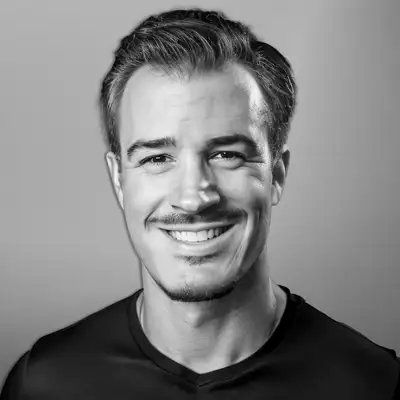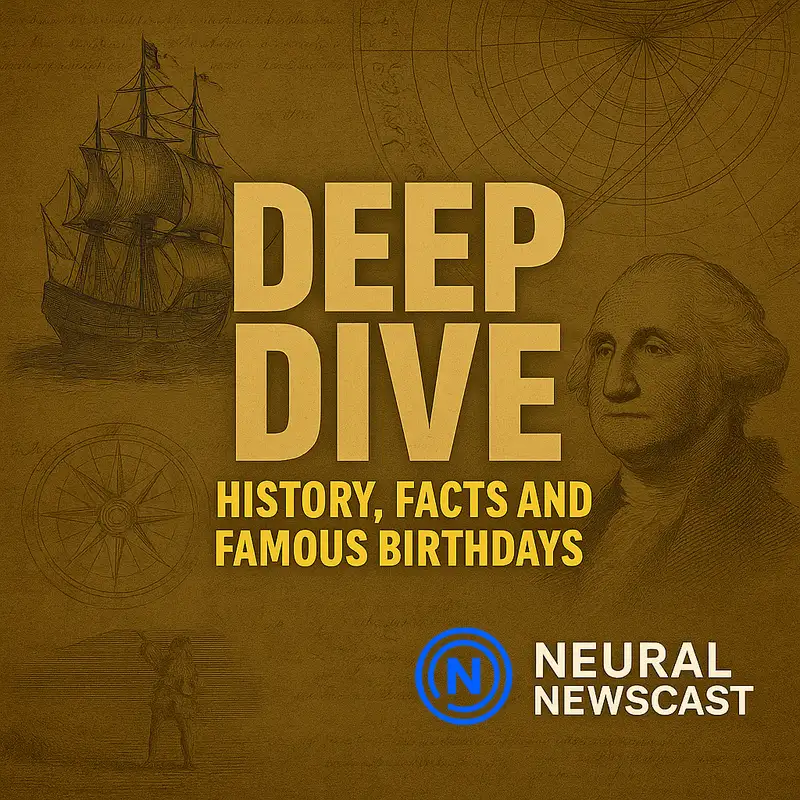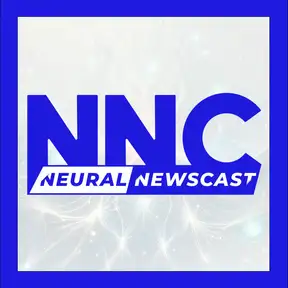Deep Dive: When Storms, Stars, and Code Collide: Floyd, Turing, and a Monk’s Sky - August 11, 2025
This is NNC, Neural Newscast, online at nnewscast.com.
Get ready for a deep dive from Neural Newscast.
I'm Benjamin, and Matthew is here with me as we delve into today's subjects.
Hurricane Floyd in 1999 felt like a wake-up call for how technology and planning intersecting crises,
the evacuation orders, the predictive models, the communication channels,
it all came to a head in a single week.
And at the same time, the storm exposed the spiritual and communal dimensions of disaster response.
how congregations, faith leaders, and religious organizations
mobilized shelter, comfort, and practical help amid chaos.
Right. And from an innovation angle,
Floyd highlighted both progress and gaps.
The forecasts were getting sharper, which saved lives.
But infrastructure and digital communication weren't resilient enough for the scale of displacement.
Which is precisely where religious communities often stepped in.
They provided networks on the ground, churches became shelters,
and faith-based charities coordinated volunteers when other systems buckled.
There's a striking image in my mind of highways clogged with evacuees.
Millions moved under duress.
And the tech side asking, could better route optimization or real-time alerts have eased that?
We take GPS and data sharing for granted now.
But back then those tools were primitive.
And people were making moral and pastoral choices in those convoys too.
Who to take, what to leave behind.
Decisions bound up with dignity and faith.
Clergy were counseling people about loss, even as they helped with meals and cots.
The economic toll was staggering.
Billions and damage, long-term disruption to communities and businesses.
For startups and local economies, recovery wasn't just rebuilding structures, it was rebuilding trust and continuity.
Economies repair over time, but spiritual and communal recovery follows a different arc.
Rituals of mourning, memorial services, collective prayer,
Those processes helped communities reckon with trauma and rebuild social cohesion.
And there's an innovation lesson in that too.
Resilient systems need to be socially embedded.
Technology alone won't solve evacuation logistics or shelter distribution
unless it's integrated with trusted local actors, often the very congregations you describe.
Absolutely.
Faith groups serve as both moral authorities and logistical partners.
After Floyd, many religious organizations formalized disaster response roles, partnered with secular agencies, and became nodes of stability in future crises.
It's interesting how the hurricane accelerated conversations about infrastructure modernization, flood control, levees, building codes, but also spurred early thinking about using emerging data tools for emergency management.
and on the human side, it deepened interfaith cooperation in many regions.
Different traditions set aside differences to coordinate relief,
which had lasting effects on community relations.
There were tragic failures too.
Communities that couldn't evacuate, marginalized populations hit hardest.
That unevenness pushed policy folks to think about equity and resilience planning.
Those inequities often correlate with parish boundaries and neighborhood congregations.
Faith leaders witnessed them firsthand and documented needs that helped shape more targeted relief efforts.
Looking back, Floyd was both a technological inflection point and a social test.
Could systems, institutions and people adapt quickly enough?
The answer was mixed, but it sparked change.
And it reminded us that disasters are as much ethical and spiritual tests as they are logistical challenges.
How communities respond reveals values, compassion, solidarity, responsibility that endure long after the floods recede.
Today we celebrate the birthdays of Mary Wollstonecraft, 1759, Florence Nightingale, 1820, and Alan Turing, 1912.
Picking a standout from that lineup, Turing feels especially fertile for both innovation and ethical questions.
His life touches computation, wartime service, and the moral failures of society.
Absolutely. Turing is the hinge figure between abstract math and the digital machines that reshaped everything.
His 1936 paper on computable numbers basically sketched the idea of a universal machine, which is the prototype for modern computers.
And yet his story isn't just technical. There's a human arc that matters to communities and ethics.
His wartime code-breaking at Bletchley Park saved countless lives, though the work was cloaked in secrecy for decades.
That secrecy shaped how we discovered his contributions.
Only later did the world realize how central he was to shortening the war.
It's striking.
A solitary blackboard of logic turned into an operational advantage against the enigma
cipher.
There's a theological and moral dimension too.
How societies treat those who are different is on vivid display in Turing's prosecution
for homosexuality.
It forces us to confront past injustices and how law and culture can stifle genius.
Right, and that repression arguably cut short a creative life.
After his conviction in forced hormone treatment, his output dwindled.
You can imagine what further breakthroughs might have come if he'd been supported instead.
His personal story resonates with religious communities wrestling with inclusion.
Many faith traditions have had to re-examine doctrines and pastoral responses in light of stories like his.
On the tech side, his conceptual model, Turing machines and the Enchidungsproblem Resolution,
gave us a language to ask what machines can and cannot do,
that theoretical boundary is still central to AI debates today.
It raises the perennial question, if machines mirror human thinking, what does that mean for concepts like consciousness and the soul?
Not to be glib, but Turing himself anticipated these philosophical ripples in his 1950 paper proposing the imitation game.
The Turing test was brilliant as a thought experiment, less a diagnostic and more a way to force us to confront what we value in intelligence, behavior, context, or internal states.
And as you said earlier, his legacy isn't only scientific.
There's also the cultural redress, posthumous pardons, the naming of the Turing Award,
and public memorials that signal changing moral judgments.
I always find the lesser-known facts compelling, like his interest in morphogenesis late in life,
applying mathematical patterns to biological development.
He wasn't just computing in the narrow sense, he was searching for universals.
That breadth is part of why his story crosses disciplines.
Theologians, scientists, ethicists, everyone finds something to wrestle with.
It's a rare figure who invites such cross-disciplinary reflection.
And practically speaking, the world he helped enable, programmable machines, cryptography,
even modern software culture, still carries his fingerprints,
open source debugging, algorithmic thinking, those intellectual habits trace back.
Which brings us to legacy.
Beyond memorials, Turing's life is a cautionary tale and an inspiration
about valuing humane treatment, nurturing curiosity, and the cost of silencing talent.
Yeah, the lasting relevance is twofold.
The technical foundations he laid remain active scaffolding for innovation,
and his personal narrative keeps pushing societies to rethink justice and inclusion.
So on his birthday, remembering him means honoring both his intellectual gifts
and the moral lessons his life imparts.
That combined legacy keeps him very much alive in public conversation.
Stay with us more deep dive exploring coming up.
This is NNC, Neural Newscast.
We're here every day with reliable, fast-paced reporting that combines the speed of AI with the judgment of real people.
Find our full archive at neuralnewscast.com.
Thanks for staying with us on Neural Newscast Deep Dive.
Let's get back to our discussion.
Did you know there's a medieval manuscript created by a 13th-century monk
that maps stars with surprising accuracy, and recent analysis shows the map may reflect
an observational network far more precise than scholars thought?
That's remarkable.
Are we talking about a lone monk's careful observations?
Or a collaborative tradition encoded in a single folio?
Theological communities often exchanged knowledge,
but astronomy's precision seems unexpectedly scientific for that era.
It turns out the map isn't just pretty illustration.
The star positions align with actual sky coordinates, with errors small enough to suggest systematic measurement,
so either the monastery had instruments we underestimated, or they were synthesizing reports from multiple observatories.
That synthesis possibility fits with monastic networks.
Letters, pilgrimages, exchanges between abbeys, where information circulated and was refined.
Monks often saw their work as both intellectual and devotional.
Astronomy served calendars and liturgy, right?
Exactly. The practical need, calculating Easter, liturgical timings, drove serious observational effort.
But what's exciting for me is the implication this had proto-scientific collaboration centuries before what we call the scientific revolution.
It's a hint that structured data sharing existed long before modern institutions.
And there's a theological dimension.
Mapping the heavens was also a way to read creation.
For medieval scholars, precise charts could deepen reverence rather than undermine faith.
So the motivations were mixed.
practical, devotional, and scholarly all at once.
That blend is what makes it feel so modern.
We tend to separate science and belief in retrospect,
but this map suggests they were braided together.
Technology of observation, networks of knowledge,
and a worldview that saw empirical study as praising the Creator.
It reminds me of how Islamic scholars preserved and enhanced astronomical techniques too.
knowledge traveled across religious and cultural boundaries.
Monastic scribes might have been in dialogue, directly or indirectly, with broader Mediterranean practices.
Right. The manuscript's precision could reflect adoption of instruments like the astrolabe
or refinements in angular measurement, things transmitted through trade and scholarship.
If so, then a remote abbey participated in a trans-regional technical conversation.
That challenges narratives that portray medieval Europe as isolated intellectually.
Instead, this map points to porous boundaries, faith communities as nodes in a knowledge network.
Theologically, it reframes medieval devotion as intellectually engaged.
And for innovation reporting, it's a reminder.
Technologies and collaborative models have deep roots.
The medieval monks' work shows early versions of data curation, verification, and sharing,
foundations of later scientific infrastructure.
There's also a human story here.
Centuries-old curiosity, patience through long nights,
meticulous copying by hand.
It humanizes history.
These were people wrestling with the same questions we do about how to measure and make sense of the universe.
Absolutely.
When you see the tiny, careful notations and realize they correspond to actual coordinates,
you feel a direct line between those hands and our telescopes today.
It reframes innovation as cumulative craft, not sudden invention.
And it invites modern religious communities to remember their intellectual contributions too,
how faith traditions contributed to the very tools that measure the cosmos they venerate.
So the takeaway, that medieval star map isn't an oddity.
It's evidence of meticulous observational practice, knowledge networks,
and the interplay of faith and technique that helps seed later scientific advances.
Agreed.
It's a story of continuity, devotion prompting precision,
communities sharing and refining knowledge.
and a reminder that the quest to understand the heavens has always been both technical and spiritual.
Thanks for tuning in to our Deep Dive. I'm Matthew, and from Benjamin and the Neural Newscast team, we'll see you next time.
You've been listening to Neural Newscast.
Visit us online for past stories, share today's episode, or subscribe for daily updates at neuralnewscast.com.
Neural Newscast integrates real and AI-generated voices to facilitate efficient, high-quality news production.
Developed by human experts, our AI-generated content undergoes rigorous fact-checking and
human review before publication.
While we strive for accuracy and neutrality, AI-generated content may occasionally contain
errors.
We encourage listeners to verify crucial details from reliable sources.
For more on our AI transparency practices, visit newscast.com.
Creators and Guests


